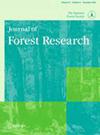日本南部寒温带森林土壤侵蚀环境变化对土壤原核生物和真菌的影响
IF 1.1
4区 农林科学
Q3 FORESTRY
引用次数: 0
摘要
摘要土壤侵蚀是土壤环境面临的主要威胁,涉及土壤理化性质的退化。虽然对土壤侵蚀对森林物理或化学性质的影响进行了研究,但对可能影响森林生态系统的土壤微生物群落的研究很少。本研究旨在阐明在日本南部寒温带混交林中,随着梅花鹿数量的增加,土壤侵蚀加速,微生物群如何随着土壤环境的变化而变化。对3个不同土壤侵蚀强度的样地土壤微生物群落进行了研究。在原核生物群落中,多样性指数随土壤侵蚀指标暴露根高(SUMH)的总和而增加。在真菌群落中,植物病原真菌和腐殖真菌的相对丰度随着SUMH的增加而增加,共生真菌和外生菌根真菌的相对丰度随着腐殖质有机质含量的增加而增加,表明侵蚀区真菌群落的组成和功能发生了变化,随着土壤侵蚀的进行,植物建立的难度会增加。此外,土壤真菌群落的共现网络比原核生物更复杂,表明土壤侵蚀对真菌网络的影响小于对细菌网络的影响。土壤侵蚀引起的土壤环境变化改变了土壤深层微生物群,对原核生物和真菌有不同程度的影响。关键词:日本山毛榉(Fagus crenata)微生物多样性多功能土壤流失共生真菌披露声明作者声明他们没有已知的竞争经济利益或个人关系可能会影响本文所报道的工作。作者contributionsA.K。Y.T,构思、设计、管理本项目,并主导本研究的资金筹措;f.c.、a.k.、M.O.和Y.T.负责样本和数据收集以及原始数据管理;F.C.和Y.T.设计和分析研究数据,并准备了草案;所有作者都对稿件进行了严格的审阅和撰写。数据可用性资料原核生物16S rDNA和真核生物18S rRNA基因的原始序列数据均已提交到DDBJ数据库的sequence Read Archive中,登录号为DRA015283。地理位置信息32°22′N, 131°11′E,32°22′N, 131°08′E,32°09′N, 130°55′s补充资料本文补充资料可在https://doi.org/10.1080/13416979.2023.2265006Additional获取。基金资助:日本生命保险基金(2021-03),日本文部科学省优秀青年研究先导计划(资助号:JPMXS0320220123),日本文部科学省优秀青年研究先导计划(资助号:JPMXS0320220123)。日本科学促进会科学研究资助(B)(批准号22H03793)。本文章由计算机程序翻译,如有差异,请以英文原文为准。
Effects of soil environmental changes accompanying soil erosion on the soil prokaryotes and fungi of cool temperate forests in Southern Japan
ABSTRACTSoil erosion, which involves the degradation of the physical and chemical properties of soil, is a major threat to the soil environment. Although the effects of soil erosion on the physical or chemical properties of forests have been studied, little has been reported on the soil microbial community, which is likely to affect forest ecosystems. This study aimed to elucidate how the microbiome changed with the soil environment accompanying soil erosion in cool temperate mixed forests in Southern Japan, where soil erosion has been accelerated by the increased population of sika deer. We investigated the soil microbial communities of the different soil erosion intensities at three forest sites. In prokaryotic communities, diversity indices were increased with the sum of the height of exposed roots (SUMH), an index of soil erosion. In fungal communities, the relative abundances of plant pathogenic and wood saprotroph fungi were increased as SUMH increased and those of symbiotrophs and ectomycorrhizal fungi were increased with humus organic matter content, suggesting that the difficulties in establishing plants would be increased as soil erosion progressed because of the changes in the composition and function of fungal communities in eroded areas. Moreover, soil fungal communities had a more complex co-occurrence network than that of prokaryote, suggesting that the effects of soil erosion on fungal network is smaller than those on bacterial network. Changes in the soil environment induced by soil erosion altered the microbiomes in the deeper layers of the soil and had different effect on prokaryotes and fungi.KEYWORDS: Japanese beech (Fagus crenata)Microbial diversityMultifunctionalitySoil lossSymbiotrophic fungi Disclosure statementThe authors declare that they have no known competing financial interests or personal relationships that could have appeared to influence the work reported in this paper.Author contributionsA.K. and Y.T, conceptualized, designed, and administrated this project, and lead the funding acquisition of this study; F.C., A.K., M.O. and Y.T. conducted the sample and data collections and raw data curation; F.C. and Y.T. designed and analyzed the study data and prepared the draft; all authors reviewed manuscript critically and wrote the manuscript.Data availability materialsAll the raw sequence data of the prokaryotic 16S rDNA and eukaryotic 18S rRNA genes were submitted in the Sequence Read Archive of DDBJ database under the accession number DRA015283.Geolocation information32°22’N, 131°11’E,32°22ʹN, 131°08ʹE,32°09’N, 130°55’ESupplementary materialSupplemental data for this article can be accessed online at https://doi.org/10.1080/13416979.2023.2265006Additional informationFundingThis work was financially supported by Nippon Life Insurance Foundation (2021-03), Leading Initiative for Excellent Young Researchers from the Ministry of Education, Culture, Sports, Science and Technology, Japan (Grant Number JPMXS0320220123), and Japan Society for the Promotion of Science Grant-in-Aid for Scientific Research (B) (Grant Number 22H03793).
求助全文
通过发布文献求助,成功后即可免费获取论文全文。
去求助
来源期刊

Journal of Forest Research
农林科学-林学
CiteScore
3.00
自引率
6.70%
发文量
62
审稿时长
3 months
期刊介绍:
Journal of Forest Research publishes original articles, reviews, and short communications. It covers all aspects of forest research, both basic and applied, with the aim of encouraging international communication between scientists in different fields who share a common interest in forest science.
 求助内容:
求助内容: 应助结果提醒方式:
应助结果提醒方式:


